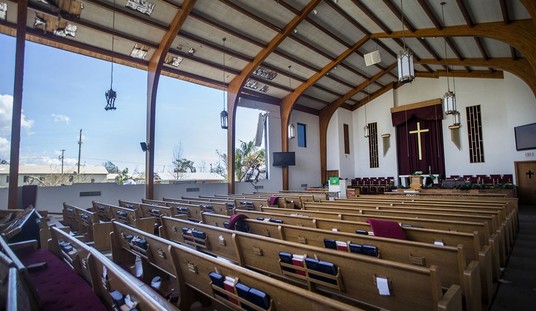One of the bigger battles between so-called “law and order” conservatives and more fiscally minded conservatives (and libertarians) is the one over justice reform. There’s been a major shift towards the latter with Republicans like Georgia Governor Nathan Deal and former Texas Governor Rick Perry deciding it’s best to overhaul the current justice system to make sure taxpayers aren’t seeing their dollars spent on failed programs. But the “law and order” conservatives are now pushing back against this idea, with Arkansas Senator Tom Cotton suggesting not enough people are being locked up. The latest salvo is from Manhattan Institute’s Heather Mac Donald, who writes in National Review how people are actually more safe if criminals are behind bars.
A few questions present themselves. How many convicts were living in a stable relationship with the mother (or one of the mothers) of their children before being sent upstate? (Forget even asking about their marriage rate.) What kind of positive guidance for young people comes from men who are committing enough crimes to end up in prison, rather than on probation (an exceedingly high threshold)? Further, if [Columbia Law School professor Jeffrey] Fagan is right that keeping criminals out of prison and on the streets preserves a community’s social capital, inner cities should have thrived during the 1960s and early 1970s, when prison resources contracted sharply. In fact, New York’s poorest neighborhoods — the subject of Fagan’s analysis — turned around only in the 1990s, when the prison population reached its zenith.
Mac Donald also posits more police resources would be spent patrolling high-crime areas if criminals were given probation over prison. She believes police give an extra eye to neighborhoods filled with ex-cons because “ex-cons commit a lot of crime.” There’s a certain truth to that, but Mac Donald fails to explain why ex-cons end up back in prison. The Texas Public Policy Foundation actually studied the issue in the state last year and found a part of the problem has to do with offenders who end up in state jail versus offenders who are put in state prison.
Specifically, looking at state jail recidivists in Texas, 63 percent of those released in 2008 were rearrested within three years. And 31 percent of state jail offenders released in 2009 were reconvicted within three years. By comparison, Texas’ prisoners were rearrested and reconvicted at rates of 47 percent and 23 percent, respectively. Those on felony direct supervision fared even better with a revocation rate of fifteen percent; moreover, half of those revocations were for technical violations, not new crimes. Ex-prisoners, parolees, and probationers may be more successful because they receive more guidance, supervision, and support upon reentry.
This is an important thing for “law and order” conservatives like Mac Donald and Cotton to remember before they go talking about putting more people behind bars. There’s nothing wrong with the state making sure offenders have true guidance instead of the occasional talk to a probation officer. This may even help rebut Mac Donald’s complaint of how families are influenced by ex-cons, especially younger teens and children. There are plenty of books like Ed Brubaker and Sean Phillips’ Criminal, the movie Boyz n the Hood, or games like Grand Theft Auto 5 which back up this line of thinking. But TPPF points out how focusing the criminal justice system on rehabilitation helps solve the recidivism rate.
More rehabilitative reentry services could help insulate communities from any poverty, unemployment, or crime that may increase with released offenders while simultaneously providing offenders more resources that could improve their chances at successful reintegration. About 15 years ago, Harris County strongly showed these patterns and prospects. A fourth of all people released from Texas state jails and prisons returned to Harris County. At the time, 52 percent of the county’s returning confinees were unsupervised upon release. And the majority was concentrated in the most disadvantaged areas of Houston. Many people leaving jail for these disadvantaged communities were from there originally. This study is an example of how the cycling of residents in and out of the criminal justice system may create social disorder and increase crime. These communities tend to have more poverty, unemployment, and crime. They also generally lack human service providers to help with needs such as housing, employment, and substance abuse. Profiles of these neighborhoods indicate a significant disparity in financial and human capital. Reentry services could give people returning to these disadvantaged communities a better chance at successful reentry
TPPF also notes how focusing on rehab and supervision actually lowers costs. Their study found the state pays about $43 per day for state jail offenders, while the total cost of community supervision, substance abuse outpatient treatment, and Texas’ Treatment Alternatives to Incarceration Program is less than $15 per day. This is throughout Texas (and has nothing to do with the fact we’re pretty nice people down here).
It isn’t just TPPF which found justice reform actually saves money and lives. Jason Pye at FreedomWorks wrote earlier this month on the issue:
The best research, such as William Spelman’s “The Limited Importance of Prison Expansion,” estimates that 25 percent of the reduction in crime in the 1990s is attributed to lengthy prison sentences. This means that 75 percent of the decline in crime rates from this period were a result of other factors, many of which are debated. But in a 2004 study, Steven Levitt, economist and co-author of Freakonomics, who subscribed to the theory that incarceration played a partial role in the decline of crime rates, warned of the eventuality of diminishing returns…What about the impact on communities? Well, the status quo — lengthy sentences and the lack of meaningful rehabilitative programming — is unsustainable because it is actually a real problem for many areas of the country. A 2014 National Research Council of the National Academies study, The Growth of Incarceration in the United States: Exploring Causes and Consequences, explained that the effects of status quo are actually making existing problems worse.
“The rise in incarceration rates marked a massive expansion of the role of the justice system in the nation’s poorest communities. Many of those entering prison come from and will return to these communities. When they return, their lives often continue to be characterized by violence, joblessness, substance abuse, family breakdown, and neighborhood disadvantage,” the study explained. “It is difficult to draw strong causal inferences from the research, but there is little question that incarceration has become another strand in the complex combination of negative conditions that characterize high-poverty communities in U.S. cities.”
Georgia has also seen its prison population drop from being fourth highest in the nation to around 54K inmates plus nonviolent offenders moved out of prison and into different programs. South Carolina has closed prisons because there’s no need for them. Oklahoma enacted justice reform initiatives this year because the prison system was costing $500M per year. Justice reform is working, whether people want to admit it or not.
Here’s the most important part: none of the justice reform advocates on the Right want to see violent offenders go unpunished. We’re not suggesting murderers or rapists should be released if they haven’t served out their full sentence or that evil doesn’t exist in the world. What we are suggesting is there are better ways to rehabilitate offenders, without laying a huge financial burden on taxpayers. The stats back it up. For politicians and pundits to suggest otherwise is either pandering to a particular lobby for money and votes, or just being stiff-necked and not looking at the facts..








Join the conversation as a VIP Member